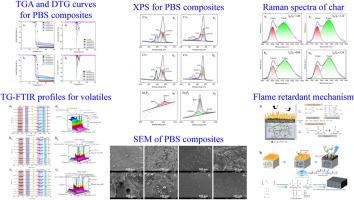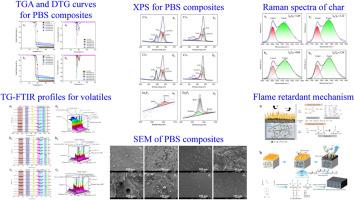Sustainable flame retardant design for biodegradable polybutylene succinate using tea residue-derived additives
IF 4.5
2区 化学
Q2 POLYMER SCIENCE
引用次数: 0
Abstract
To address pressing environmental concerns such as net-zero emissions and the circular economy, this study presents a novel, sustainable intumescent flame retardant (IFR) system derived from agricultural waste, tea residues (TRs). TRs were combined with ammonium polyphosphate (APP) as an acid source and melamine (MEL) as a gas source at a mass ratio of 1:3:1 to form a synergistic TR/APP/MEL (TRAM) flame retardant, which was incorporated into biomass-based polybutylene succinate (PBS) to produce flame-retardant biocomposites. As an effort to further enhance charring efficiency, zinc oxide (ZnO) was introduced as a catalyst, preparing a second IFR system, TR/APP/ZnO (TRAZO). Combustion testing showed that incorporating 30 wt% TRAM into PBS increased the limiting oxygen index (LOI) from 22 % (neat PBS) to 40 % and achieved a UL-94 V-0 rating with no dripping. Thermogravimetric analysis (TGA) confirmed improved thermal stability, with char residue increasing from 1.98 wt% to 14.39 wt%. Additionally, the TRAZO-based composite containing only 20 wt% IFR also achieved a UL-94 V-0 rating and an LOI of 30 %, indicating that introduciton of ZnO effectively eliminated dripping of PBS composite by the graphitized char formation during combustion, thereby enhancing the flame retardancy. Cone calorimetry (CCT) results further demonstrated that TRAM significantly reduced the heat release and smoke production. These results highlight the potential of TR-derived IFRs, including TRAM and TRAZO, as green, halogen-free, and efficient flame retardants for biodegradable polymers. This approach supports the development of sustainable flame-retardant materials aligned with circular economy principles.


茶渣衍生添加剂可降解丁二酸聚丁二烯的可持续阻燃设计
为了解决诸如净零排放和循环经济等紧迫的环境问题,本研究提出了一种新型的、可持续的膨胀型阻燃剂(IFR)系统,该系统来源于农业废弃物、茶叶残留物(TRs)。将TRs与聚磷酸铵(APP)为酸源,三聚氰胺(MEL)为气源,以1:3:1的质量比组合成TR/APP/MEL (TRAM)协同阻燃剂,将其掺入生物质基聚丁二酸丁二烯(PBS)中制备阻燃生物复合材料。为了进一步提高炭化效率,引入氧化锌(ZnO)作为催化剂,制备了第二种IFR体系TR/APP/ZnO (TRAZO)。燃烧测试表明,在PBS中加入30 wt%的TRAM可将极限氧指数(LOI)从22%(纯PBS)提高到40%,并在无滴落的情况下达到UL-94 V-0等级。热重分析(TGA)证实了热稳定性的提高,炭渣从1.98 wt%增加到14.39 wt%。此外,仅含20 wt% IFR的trazo基复合材料也达到了UL-94的V-0等级和30%的LOI,这表明ZnO的引入有效地消除了燃烧过程中石墨化炭形成的PBS复合材料的滴下,从而提高了阻燃性。锥热法(CCT)结果进一步表明,TRAM显著减少了热量释放和烟雾产生。这些结果突出了tr衍生的ifr,包括TRAM和TRAZO,作为绿色、无卤和高效的生物可降解聚合物阻燃剂的潜力。这种方法支持符合循环经济原则的可持续阻燃材料的开发。
本文章由计算机程序翻译,如有差异,请以英文原文为准。
求助全文
约1分钟内获得全文
求助全文
来源期刊

Polymer
化学-高分子科学
CiteScore
7.90
自引率
8.70%
发文量
959
审稿时长
32 days
期刊介绍:
Polymer is an interdisciplinary journal dedicated to publishing innovative and significant advances in Polymer Physics, Chemistry and Technology. We welcome submissions on polymer hybrids, nanocomposites, characterisation and self-assembly. Polymer also publishes work on the technological application of polymers in energy and optoelectronics.
The main scope is covered but not limited to the following core areas:
Polymer Materials
Nanocomposites and hybrid nanomaterials
Polymer blends, films, fibres, networks and porous materials
Physical Characterization
Characterisation, modelling and simulation* of molecular and materials properties in bulk, solution, and thin films
Polymer Engineering
Advanced multiscale processing methods
Polymer Synthesis, Modification and Self-assembly
Including designer polymer architectures, mechanisms and kinetics, and supramolecular polymerization
Technological Applications
Polymers for energy generation and storage
Polymer membranes for separation technology
Polymers for opto- and microelectronics.
 求助内容:
求助内容: 应助结果提醒方式:
应助结果提醒方式:


